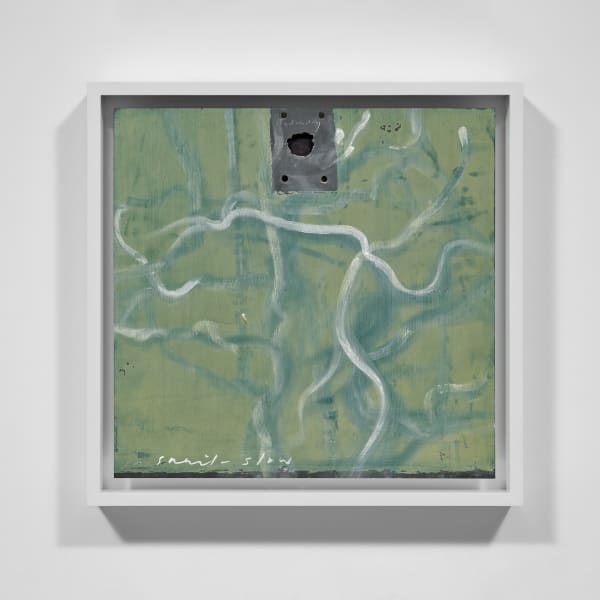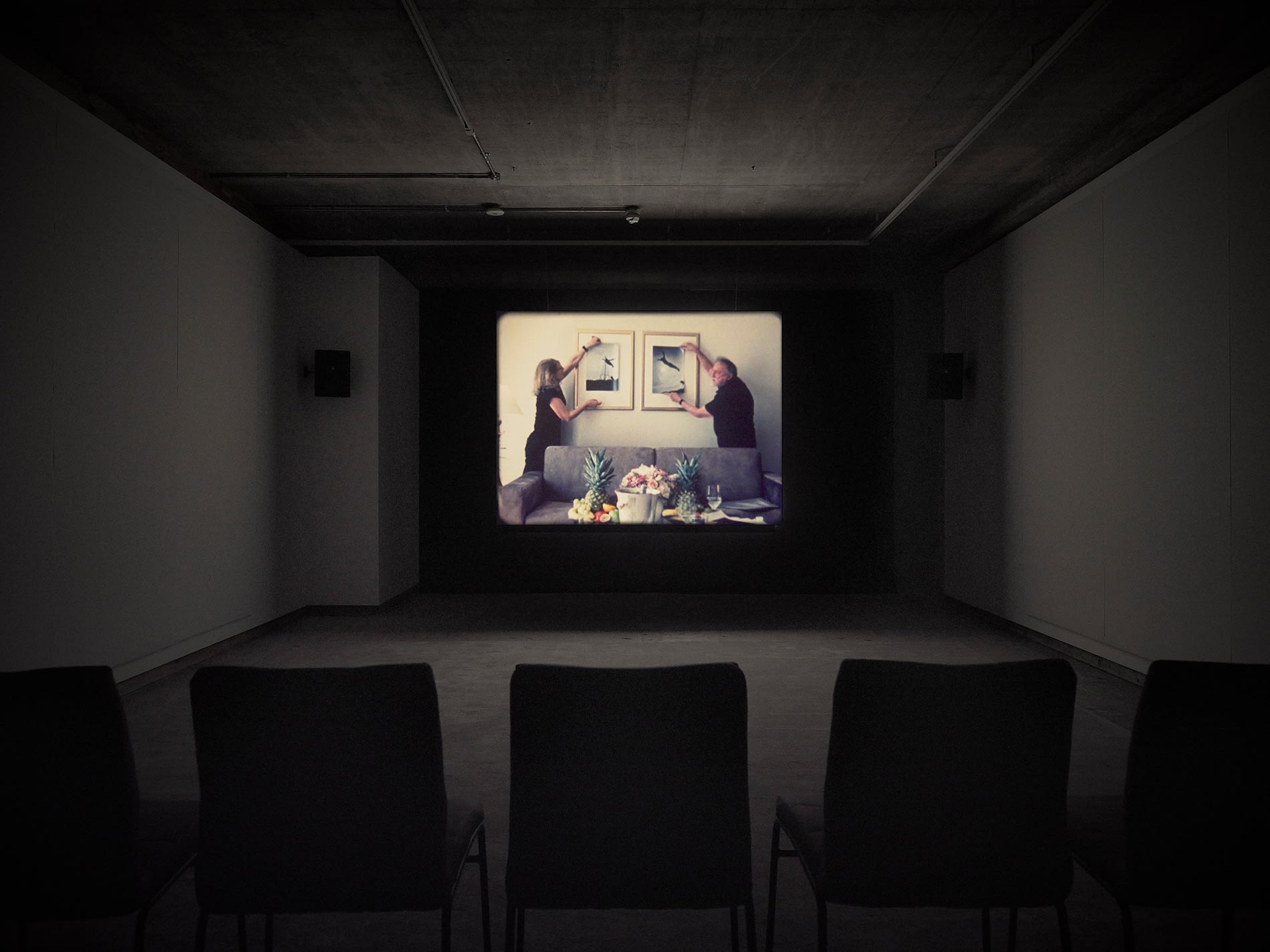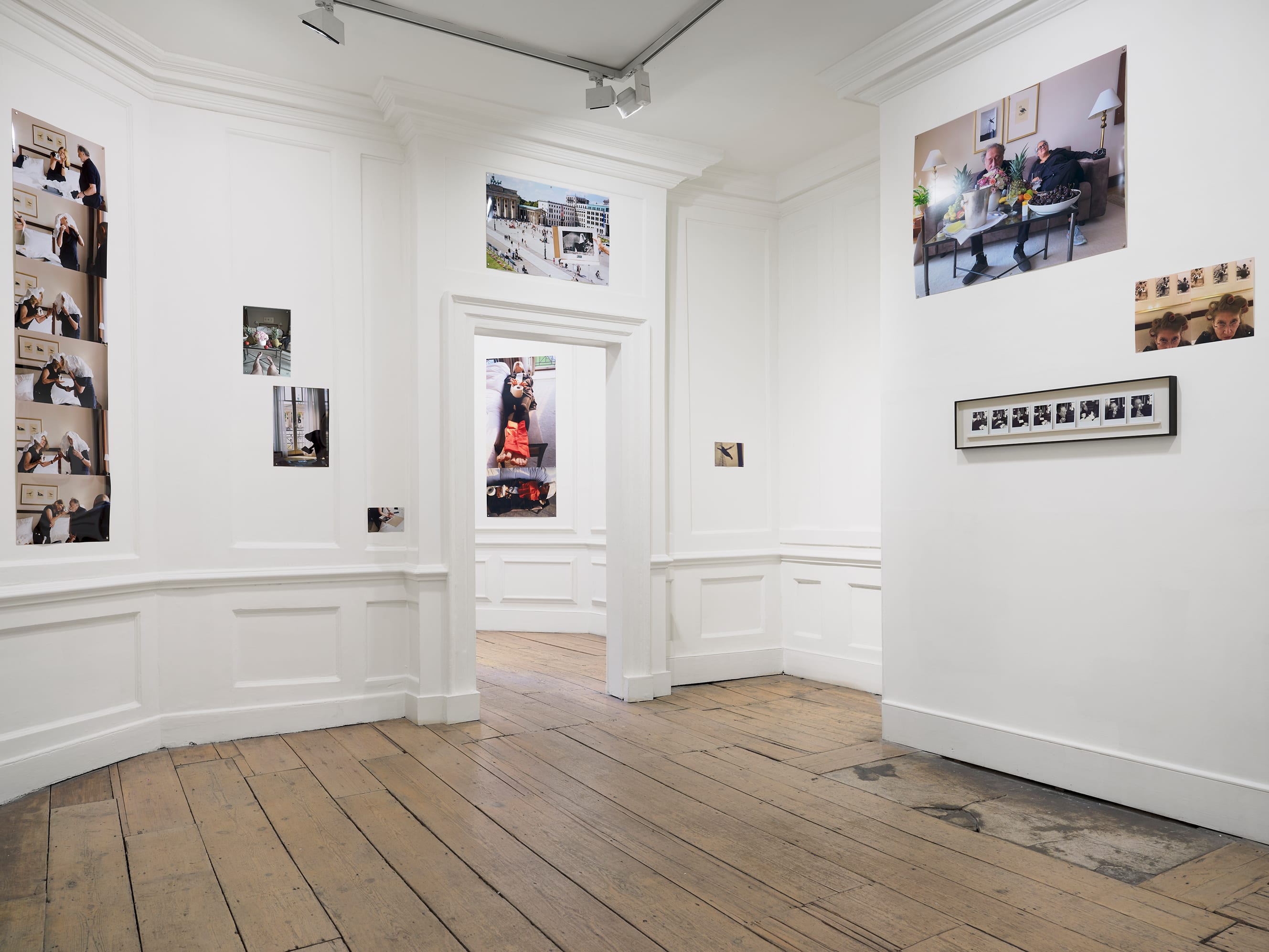Tacita Dean
-
Golden Square
Black, Grey, Green and White and If I were in the Adlon
Soho Square
Because my secret is my duty
Tacita Dean, Mathew Hale, Boris and Vita Mikhailov
24 September–22 November 2025 (open Friday and Saturday)
-
-
Black, Grey, Green and White
The exhibition at Golden Square brings together new works on slate and glass, an edition of prints as well as the first showing of a 39-minute 16mm film, If I were in the Adlon. The title Black, Grey, Green and White is from A Midsummer Night's Dream, and is taken from the artist's copy of A Complete Concordance to Shakespeare, which she often uses to title her drawings on slate. The colours symbolise the play's contrasting worlds and resonated with her in the context of the exhibition due to the hues of the different surfaces she is currently using.
-

-
In late 2024, MACK published Base Matter and Uncommon Solvent, a comprehensive book of Dean’s drawings that highlights works where the form itself derives from the surfaces or supports she uses. The nature of the presentation of the pieces in this exhibition sets out to exemplify this approach to drawing.
Dean has been drawing on found, grey school slates for over a decade but was recently given some that had been painted green (from the era when that colour was considered to be gentler on the eye). The paint had oxidised creating a febrile powdery surface, which necessitated a change of approach to how it could be worked with.
-
'Drawing is the thread running through everything I do, whether on slate, glass or film. What matters most is that it is an authentic act: the moment when light transforms silver in a negative, or chemicals react in emulsion.'
-
-
In April 2024, Dean travelled to Eagle Pass in Texas to watch a total eclipse of the sun. On this occasion she was determined to simply experience the eclipse without feeling the need to document it. So, with little expectation and some lassitude, she twisted and turned her camera without looking through the viewfinder, in the way she had recently done for her Why Cy project at The Menil Collection in Houston. When the negatives were processed, she saw that she had in fact made a series of Eclipse Drawings, which became a new edition of screen prints created with Gemini GEL in Los Angeles, these are being exhibited here for the first time. Their looping solar streaks have also informed the green slate drawings along with other slate pieces made in Los Angeles this summer.
-

Eclipse Drawing 3, 2025
-
-

-
The exhibition also includes works made on glass, some of which are Locomotive Drawings. The form of these derives from the idea that the advent of speed through locomotion correlated with the invention of cinema and the ability to perceive the passing landscape seemingly broken into frames by the rectangle of the train window. Using a stack of Victorian-era train carriage windows retrieved from an elderly neighbour, Dean worked with a studio in Germany to develop a way to make drawings on the back of the antique glass.
-
-

Desiderio, 2025
-
If I were in the Adlon
On show in the lower gallery at Golden Square is If I were in the Adlon, a new 16mm film featuring the Ukrainian artist Boris Mikhailov and Vita Mikhailov, his wife, collaborator and muse, during one afternoon in the eponymous Berlin hotel. The Adlon is the city’s most historical hotel and sits beside the Brandenburg Gate at the start of Unter den Linden. It is located in what was The East, next to the Russian Embassy, so was for a long time at the centre of Cold War intrigue and espionage. Barack Obama stayed there when he gave his famous speech in front of the Brandenburg Gate before being elected president in 2008 and it was off a balcony at the Adlon that Michael Jackson dangled his baby.
Tacita Dean and her husband Mathew Hale have been friends with Boris and Vita since moving to Berlin in the year 2000. Dean had long wanted to make a film with them but was never sure how, until in 2024, a friend offered her a voucher for ‘a night in the Adlon,’ that she’d won in a tombola.
-

If I were in the Adlon, 2025
-
As Dean explains:
“Boris and Vita took up the challenge of spending the night in the Adlon Hotel without much, if any, direction from me. The only decision I made, apart from choosing a suite with a view of the Brandenburg Gate, was to bring Mathew into the film. Boris and Vita are Russian speakers from Kharkiv. Vita translates for Boris and that is their particular dynamic. In order for her to translate for the viewer too, it was important to bring in a non-Russian speaking third party. The film has no subtitles because it is made as it would be to encounter them in real life. I never know what they are saying to each other and it becomes unnecessary to know because the essence of what they’re communicating is clearly manifested through their animation and immense charm. It is how most of us who speak no Russian know them.
Boris and Vita, and Mathew brought props with them to the room. They didn’t discuss it with each other ahead of time and certainly not with me. When Mathew put a 19th century painted copy of Jacques-Louis David’s Death of Marat onto the hotel bed, I asked him to put it elsewhere so he put it in the bathroom, which would later become significant. He also brought a small Meissen figure of Cupid. Boris and Vita brought some of their photographs, and Vita her Vivienne Westwood ‘too young to die’ dress that she had found in the Berlin flea market. All I did was to arrange the delivery of Ukrainian vodka and honey cake.”
What evolved in front of the film camera grew out of the contingency of all these elements making sense in that moment – the hotel with its view looking east to west onto the Brandenburg Gate, the suite, the props, the hot afternoon and most especially the personalities of Boris and Vita Mikhailov.
-
Tacita Dean, Mathew Hale, Boris and Vita Mikhailov
Because my secret is my dutyOn display at Soho Square is a collaborative exhibition of photographs taken by Boris and Vita Mikhailov, Mathew Hale and Tacita Dean made during and after the filming of If I were in the Adlon (2025).
“Getting ready for this strange journey, of one day long, just yesterday we had no idea what we would have to do... And so, in the city where we have a place to live, we leave home to a very significant historical place in the city, not fully understanding the purpose of our movement... And we, like tightrope walkers, carefully balancing, make our movement.”
Extracted from: 'Adlon' by Boris Mikhailov, 2 August 2024, Hotel Adlon, Berlin.
-

-
The downstairs gallery at Golden Square is accessed by 21 steps. We regret that it is not wheelchair accessible. Please get in touch for more information.
Golden Square is open Tuesday–Friday, 11–6pm and Saturday 11–5pm.
Soho Square will be open Friday and Saturday and by appointment.
-

-

-

-

-
Artwork Photography: Studio Tacita Dean / Simon Hanzer
Installation Photography: Stephen White & Co
















